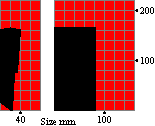Royal Digital III and Digital IV
In January 1972 the magazine "Electronics" announced two highly competitively priced hand-held calculators under the 'Royal' label[1]:
"... Royal Consumer
Products division, Hartford, Conn., a part of Litton Industries. With its Digital III and IV, made by the Monroe division of Litton, Royal is in a position to market these units to consumer outlets, from mass merchandisers to
the corner stationery shop. With quantity discounts and prompt payment, dealers get these machines for under $90. Suggested retail prices are $139 and $149 [about £58 & £62 Sterling]."
What was very unusual about these models, apart from the low price, was that they did not use a normal keypad for input but a stylus touching gold-plated pads on the circuit board. The Royal Digital III also reduces cost further by only having a 4-digit display.
Royal Digital III

Royal Digital III
Distinctive features: Low-cost hand-held calculator, achieved by eliminating normal keys, having only a 4-digit display, and employing a "calculator-on-a-chip".
Technical details:
Display is 4 digits, blue individual vacuum fluorescent tubes.
Calculations are actually performed to 8 digits and the display can be swapped between the high 4
digits and the low 4 digits using the "<->" key.
4-function.
Is operated by touching the circuit board through the windows in the casing using the stylus.
Main integrated circuit - General Instruments GI 250 "calculator-on-a-chip" (here date coded 7208).
7.2 v (6 x AA rechargeable cells).
81 mm x 165 mm x 39 mm (3.2" x 6.5" x 1.6").
Introduced late 1971/early 1972.
Made in U.S.A. by Royal Typewriter Company, Hartford, Conn.


With the cover removed to reveal the circuit board with the gold-plated stylus contact areas.
The main circuit board carries the calculator integrated circuit and the four display tubes. The base of the calculator holds a pack of six AA size rechargeable cells.


Royal Digital IV
Distinctive features: Low-cost hand-held calculator, achieved by eliminating normal keys and employing a "calculator-on-a-chip".
Technical details:
Display is 8 digits, red LED.
4-function.
Is operated by touching the circuit board through the windows in the casing using the stylus.
Main integrated circuit - General Instruments GI 251 "calculator-on-a-chip" (here date coded 7206).
7.2 v (6 x AA rechargeable cells).
81 mm x 165 mm x 39 mm (3.2" x 6.5" x 1.6").
Introduced late 1971/early 1972.
Made in U.S.A. This example "Made in USA for Imperial Typewriter Company Limited, Leicester, England".
In Britain this model was also marketed as the Imperial I.C.-90 (link to associated 'Vintage British Calculators' site).
Price in UK, June 1972, £52-50[2].
The cover of the instruction leaflet - "the Magic Stylus Calculator".


With the cover removed to reveal the circuit board with the gold-plated stylus contact areas and the LED display.

The main circuit board carries the calculator integrated circuit while the base of the calculator holds a pack of six AA size rechargeable cells.

At this time 'Royal', 'Imperial Typewriter', and 'Monroe' were all trade names of the Litton Industries empire.
At this time calculator keyboards were complicated and expensive components. To cut this cost these calculators present gold-plated pads on the circuit board through the front of the calculator. Touching a pad with the electrically
connected stylus has the same effect as pressing a key on a standard calculator.
Only the Royal Digitial III, the Royal Digitial IV and its British version the Imperial I.C.-90 are known to have this stylus feature.
These calculators are also among the first to employ "calculator-on-a-chip" integrated circuits.
See also the article "The Calculator-on-a-Chip" on this site.
References:
Hand-held Calculators
Vintage Calculators
Text & photographs copyright, except where stated otherwise, © Nigel Tout 2000-2025.